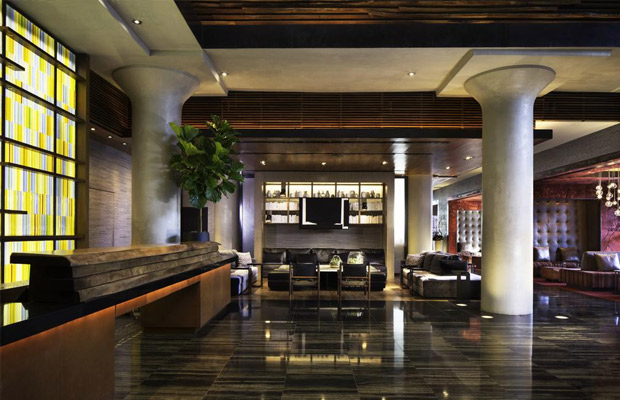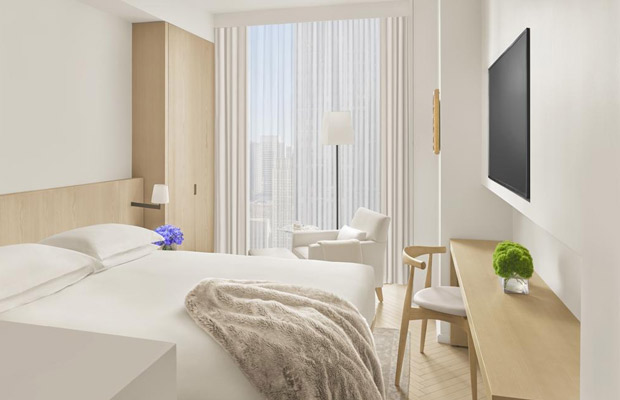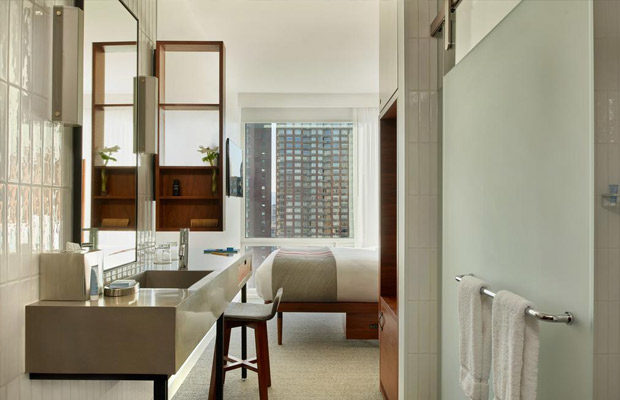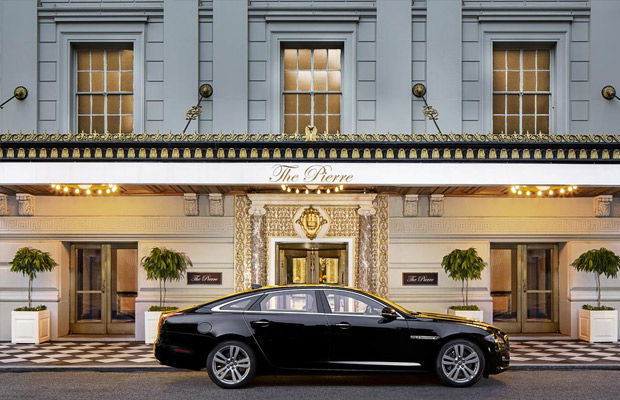Solomon R. Guggenheim Museum
Solomon R. Guggenheim Museum
USA
New York
New York Travel Guide
Book Tour & Activities
Your tour in New York.
Book your stay
Your hotel in New York.
Overview
The Solomon R. Guggenheim Museum, often referred to as The Guggenheim, is an art museum located at 1071 Fifth Avenue on the corner of East 89th Street in the Upper East Side neighborhood of Manhattan, New York City. It is the permanent home of a continuously expanding collection of Impressionist, Post-Impressionist, early Modern, and contemporary art and also features special exhibitions throughout the year.
The museum was established by the Solomon R. Guggenheim Foundation in 1939 as the Museum of Non-Objective Painting, under the guidance of its first director, Hilla von Rebay. It adopted its current name in 1952, three years after the death of its founder Solomon R. Guggenheim. In 1959, the museum moved from rented space to its current building, a landmark work of 20th-century architecture designed by Frank Lloyd Wright. The cylindrical building, wider at the top than at the bottom, was conceived as a "temple of the spirit". Its unique ramp gallery extends up from ground level in a long, continuous spiral along the outer edges of the building to end just under the ceiling skylight.
History
Early years and Hilla Rebay
Solomon R. Guggenheim, a member of a wealthy mining family, had been collecting works of the old masters since the 1890s. In 1926, he met artist Hilla von Rebay,[7] who introduced him to European avant-garde art, in particular abstract art that she felt had a spiritual and utopian aspect (non-objective art).[7] Guggenheim completely changed his collecting strategy, turning to the work of Wassily Kandinsky, among others. He began to display his collection to the public at his apartment in the Plaza Hotel in New York City.[7][8] As the collection grew, he established the Solomon R. Guggenheim Foundation, in 1937, to foster the appreciation of modern art.[8]
The Museum of Non-Objective Painting
Albert Gleizes, 1915, Composition for "Jazz", oil on cardboard, 73 × 73 cm
The foundation's first venue for the display of art, the "Museum of Non-Objective Painting", opened in 1939 under the direction of Rebay, in midtown Manhattan.[9] Under Rebay's guidance, Guggenheim sought to include in the collection the most important examples of non-objective art available at the time by early modernists such as Rudolf Bauer, Rebay, Kandinsky, Piet Mondrian, Marc Chagall, Robert Delaunay, Fernand Léger, Amedeo Modigliani and Pablo Picasso.
By the early 1940s, the foundation had accumulated such a large collection of avant-garde paintings that the need for a permanent museum building had become apparent.[11] In 1943, Rebay and Guggenheim wrote a letter to Frank Lloyd Wright asking him to design a structure to house and display the collection.[12] Wright accepted the opportunity to experiment with his organic style in an urban setting. It took him 15 years, 700 sketches, and six sets of working drawings to create the museum.
In 1948, the collection was greatly expanded through the purchase of art dealer Karl Nierendorf's estate of some 730 objects, notably German expressionist paintings.[10] By that time, the foundation's collection included a broad spectrum of expressionist and surrealist works, including paintings by Paul Klee, Oskar Kokoschka and Joan Miró.[10][14] After Guggenheim's death in 1949, members of the Guggenheim family who sat on the foundation's board of directors had personal and philosophical differences with Rebay, and in 1952 she resigned as director of the museum.[15] Nevertheless, she left a portion of her personal collection to the foundation in her will, including works by Kandinsky, Klee, Alexander Calder, Albert Gleizes, Mondrian and Kurt Schwitters. The museum was renamed the Solomon R. Guggenheim Museum in 1952.
Design
Rebay conceived of the space as a "temple of the spirit" that would facilitate a new way of looking at the modern pieces in the collection. She wrote to Wright that "each of these great masterpieces should be organized into space, and only you ... would test the possibilities to do so. ... I want a temple of spirit, a monument!"[16][17] The critic Paul Goldberger later wrote that, before Wright's modernist building, "there were only two common models for museum design: Beaux-arts Palace ... and the International Style Pavilion."[18] Goldberger thought the building a catalyst for change, making it "socially and culturally acceptable for an architect to design a highly expressive, intensely personal museum. In this sense almost every museum of our time is a child of the Guggenheim."
The museum's atrium
From 1943 to early 1944, Wright produced four different sketches for the initial design. While one of the plans (scheme C) had a hexagonal shape and level floors for the galleries, all the others had circular schemes and used a ramp continuing around the building. He had experimented with the ramp design in 1948 at the V. C. Morris Gift Shop in San Francisco and on the house he completed for his son in 1952, the David and Gladys Wright House in Arizona.[19] Wright's original concept was called an inverted "ziggurat", because it resembled the steep steps on the ziggurats built in ancient Mesopotamia.[20] His design dispensed with the conventional approach to museum layout, in which visitors are led through a series of interconnected rooms and forced to retrace their steps when exiting.[21] Wright's plan was for the museum guests to ride to the top of the building by elevator, to descend at a leisurely pace along the gentle slope of the continuous ramp, and to view the atrium of the building as the last work of art. The open rotunda afforded viewers the unique possibility of seeing several bays of work on different levels simultaneously and even to interact with guests on other levels.
At the same time, before settling on the site for the museum at the corner of 89th Street and the Museum Mile section of Fifth Avenue, overlooking Central Park, Wright, Rebay and Guggenheim considered numerous locations in Manhattan, as well as in the Riverdale section of the Bronx, overlooking the Hudson River.[23] Guggenheim felt that the site's proximity to Central Park was important; the park afforded relief from the noise, congestion and concrete of the city.[20] Nature also provided the museum with inspiration.[23] The building embodies Wright's attempts "to render the inherent plasticity of organic forms in architecture".[21] The Guggenheim was to be the only museum designed by Wright. The city location required Wright to design the building in a vertical rather than a horizontal form, far different from his earlier, rural works.
Staircase at the Vatican Museums designed by Giuseppe Momo in 1932
The spiral design recalled a nautilus shell, with continuous spaces flowing freely one into another.[25] Even as it embraced nature, Wright's design also expresses his take on modernist architecture's rigid geometry.[25] Wright ascribed a symbolic meaning to the building's shapes. He explained, "these geometric forms suggest certain human ideas, moods, sentiments – as for instance: the circle, infinity; the triangle, structural unity; the spiral, organic progress; the square, integrity."[26] Forms echo one another throughout: oval-shaped columns, for example, reiterate the geometry of the fountain. Circularity is the leitmotif, from the rotunda to the inlaid design of the terrazzo floors.[23] Several architecture professors have speculated that the double spiral staircase designed by Giuseppe Momo in 1932 at the Vatican Museums was an inspiration for Wright's ramp and atrium. Jaroslav Josef Polívka assisted Wright with the structural design and managed to design the gallery ramp without perimeter columns.
The Guggenheim's surface was made out of concrete to reduce the cost, inferior to the stone finish that Wright had wanted.[31] Wright proposed a red-colored exterior, which was never realized.[32] The small rotunda (or "Monitor building", as Wright called it) next to the large rotunda was intended to house apartments for Rebay and Guggenheim but instead became offices and storage space.[33] In 1965, the second floor of the Monitor building was renovated to display the museum's growing permanent collection, and with the restoration of the museum in 1990–92, it was turned over entirely to exhibition space and christened the Thannhauser Building, in honor of one of the most important bequests to the museum.[34] Wright's original plan for an adjoining tower, artists' studios and apartments went unrealized, largely for financial reasons, until the renovation and expansion. Also in the original construction, the main gallery skylight had been covered, which compromised Wright's carefully articulated lighting effects. This changed in 1992 when the skylight was restored to its original design.
Address: 1071 5th Ave, New York, NY 10128, United States
Hours: Closed ⋅ Opens 11AM
Founded: 1939, Manhattan, New York, United States
Architect: Frank Lloyd Wright
Founders: Frank Lloyd Wright, Solomon R. Guggenheim, Peggy Guggenheim
Video Travel Inspiration
See Solomon R. Guggenheim Museum on Map
Most Popular Cities

Siem Reap
Cambodia
Ho Chi Minh City
Vietnam
Beijing
China
Paris
France
London
United Kingdom
New York
USA
Tokyo
Japan
Bangkok
Thailand
Seoul
South Korea
Vientiane
Laos
Yangon
Myanmar
Washington DC
USA
Los Angeles
USA
Ottawa
Canada
New Delhi
India
Singapore
Singapore
Kuala Lumpur
Malaysia
 English
English French
French Khmer
Khmer Thai
Thai Vietnamese
Vietnamese Chinese
Chinese Korean
Korean German
German Japanese
Japanese Italian
Italian Russian
Russian Spanish
Spanish Dutch
Dutch Indonesian
Indonesian Malay
Malay





































